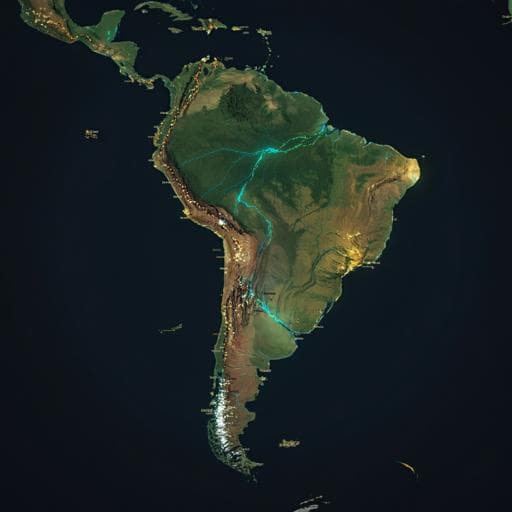
Social Work
Resolution and the detection of cultural dispersals: development and application of spatiotemporal methods in Lowland South America
P. Riris and F. Silva
This research by Philip Riris and Fabio Silva dives into the intricate use of radiocarbon datasets to explore prehistoric dispersals in lowland South America. It uncovers the complexities of data quality and chronometric uncertainty and presents a novel analytical approach that enhances our understanding of cultural mobility in the region.
~3 min • Beginner • English
Introduction
The study addresses how to robustly infer archaeological dispersal dynamics from geolocated radiocarbon datasets in lowland South America. Traditional regression approaches often use single-point summaries (e.g., calibrated medians) of dates and assume that decreasing age with increasing distance from an origin indicates dispersal. However, calibrated radiocarbon dates have substantial, non-normal uncertainties that can severely distort inferred slopes and speeds, potentially yielding misleading conclusions. The authors’ research question is whether spatiotemporal radiocarbon datasets for two emblematic South American cultural expansions (Arauquinoid and Tupiguarani) contain statistically significant evidence of a dispersal signal once full chronometric uncertainty is incorporated and explicitly tested against a null hypothesis. The work is framed within long-standing debates on dispersal processes (migration, demic diffusion, diffusion of traits) and seeks to integrate methodological rigor by testing for significance before estimating parameters such as rate-of-spread or origination time. The importance lies in establishing a reflexive, hypothesis-driven baseline for using aggregate radiocarbon data to compare archaeological evidence with climatic, linguistic, and palaeoecological records, and to guide when further data collection is necessary.
Literature Review
The paper situates itself within decades of research on pre-Columbian dispersals in lowland South America, influenced by mid-20th century archaeological, linguistic, and ethnographic traditions. It reviews known dispersal cases (e.g., Tupiguarani, Arauquinoid, Amazonian polychrome, Koriabo, Barrancoid, Southern proto-Jê) and highlights the central role of radiocarbon datasets in reconstructing spatiotemporal patterns. It references canonical work on the European Neolithic spread as a methodological template for distance–time regressions (Ammerman and Cavalli-Sforza 1971; Pinhasi et al. 2005), and subsequent methodological developments that incorporate spatial structure and heterogeneity. Critically, Hazelwood and Steele (2004) is highlighted for demonstrating that radiocarbon chronometric uncertainty can dramatically affect slope estimation and for introducing the concept of minimum chronological resolution required to detect dispersal signals. The authors note that prior archaeological applications often regress to mean trends and rely on median dates, potentially misrepresenting the earliest arrivals relevant for dispersal fronts. Quantile regression is identified as a more suitable tool for targeting early occurrences, and the need for formal significance testing against a null of no dispersal (zero slope) is emphasized. The review also discusses debates linking material culture distributions and language families (e.g., Tupi-Guarani, Cariban) and points to emerging ancient DNA and palaeodemographic research as complementary lines of evidence.
Methodology
Data: Two radiocarbon datasets were compiled from published sources, including only dates with verified context, location, and lab codes, and excluding dates with errors >±200 14C years or thermoluminescence dates due to calibration issues. The Tupiguarani dataset contains 375 dates from 234 sites; the Arauquinoid dataset contains 178 dates from 47 sites. Calibration used the rcarbon R package with SHCal20 for Tupiguarani and IntCal20 for Arauquinoid. Spatial voids are acknowledged (e.g., Guyana, interior Guiana Shield, Orinoco Delta; Paraguay and parts of the Lower Paraná/Uruguay).
Distance and origins: For each site, geodesic distance to a putative origin was computed. Origins were set to the sites with the oldest calibrated dates: Abraham for Tupiguarani and El Valle for Arauquinoid (the Arauquin type site lacks radiocarbon dates).
Regression framework: Because many dates do not represent first arrivals, ordinary least squares (regressing to the mean) is suboptimal. Quantile regression (R package quantreg) was used to target early arrivals by regressing to the 99th percentile (with robustness checks at the 90th and 95th percentiles yielding similar conclusions). The algorithm employs a modified Barrodale and Roberts method; parameter standard errors were obtained via the xy-pair approach. This approach tolerates heteroscedasticity and multimodal residuals.
Chronometric uncertainty incorporation: To propagate calibrated-date uncertainty, the authors performed Monte Carlo sampling of each calibrated probability distribution 1000 times to generate 1000 synthetic datasets. For each, a 99th-percentile quantile regression was fit, and intercept and slope estimates with standard errors were recorded.
Null model and significance testing: A bespoke significance test was developed to assess whether observed slopes differ from a null of no dispersal (zero slope) given dataset-specific uncertainty. The null model was constructed by randomly permuting the spatial (distances) and temporal (dates) components, thereby removing any spatiotemporal trend while preserving spatial/temporal extents and resolutions. For each permuted dataset, the same Monte Carlo sampling and quantile regressions were applied (1000 repetitions), and parameter estimates were aggregated by summing their normal-approximated probability distributions (asymptotic normality of quantile parameters assumed). This procedure generated summed probability distributions (SPDs) and 95% confidence envelopes for intercept and slope under the null. Two-tailed p-values were computed by comparing empirical SPDs to the null envelopes, following Timpson et al. (2014) with Monte Carlo correction (North et al. 2002), at alpha=0.05.
Validation: The methodology was validated on the Pinhasi et al. (2005) European Neolithic dataset (known east-to-west spread) and on a randomized version (dates randomly reassigned to sites). Results were as expected: significant slope (p<<0.001) for the original dataset and non-significant (p=0.999) for the randomized dataset. Source code, data, and scripts are available at https://doi.org/10.5281/zenodo.4434387.
Key Findings
- Arauquinoid: Both median-date regression and uncertainty-aware regressions yield near-flat lines. Median-date regression slope ≈ 0.021 (95% −0.201 to 0.244), p=0.853 (ns); intercept 1360 cal BP (95% 1173–1547), p<0.001. With full chronometric uncertainty: slope ≈ 0.021 (95% −0.343 to 0.343), p=0.285 (ns); intercept 1332 cal BP (95% 1086–1735), p=0.274 (ns). The positive best-estimate slope would imply east-to-west dispersal (reverse of expectations), but non-significance indicates insufficient resolution; effectively, the dataset is consistent with instantaneous or undetectably fast spread.
- Tupiguarani: Visual regressions show a negative slope, but significance testing indicates no detectable dispersal signal. Median-date regression slope ≈ −0.263 (95% −0.572 to 0.047), p=0.097 (ns); intercept 2413 cal BP (95% 1729–3097), p<0.001. With full uncertainty: slope ≈ −0.245 (95% −0.574 to 0.073), p=0.999 (ns); intercept 2414 cal BP (95% 1710–3159), p=0.999 (ns). Empirical SPDs for both slope and intercept lie within the null envelopes.
- Resolution constraints illustrated: Considering only two early Arauquinoid dates separated by >1300 km, median-based slope 0.0197 implies ~50.7 km/yr. Accounting for full calibrated 95% ranges yields slope between −0.279 and 0.339, implying speeds from ~3 km/yr to infinity and either direction of spread, underscoring how calibration uncertainty can render dispersal parameters indeterminate.
- Overall: For both case studies, available radiocarbon data lack sufficient chronological resolution to detect and parameterize dispersal dynamics; datasets are statistically indistinguishable from null models lacking spatiotemporal structure.
Discussion
The findings directly address the research question by demonstrating that when full chronometric uncertainty is incorporated and a proper null model is applied, neither the Arauquinoid nor the Tupiguarani radiocarbon datasets provide statistically significant evidence for a time–distance dispersal trend. Apparent linear trends—especially from median-date regressions—can be misleading without significance testing. The study shows that the challenge is not spatial scale but temporal resolution: when the elapsed time across a domain is comparable to the summed uncertainties of earliest dates, slopes converge toward zero and cannot be distinguished from instantaneous spread. This necessitates a more cautious interpretation of prior studies that estimated rates-of-spread or origins from similar datasets. The results encourage reflexivity in using aggregated radiocarbon dates, advocating for significance testing as a prerequisite, and for considering alternative models of cultural expansion (e.g., exchange networks, copying, rapid diffusion of traits) alongside demographic/demic diffusion. The method’s validation on the European Neolithic underscores its ability to detect real dispersal signals where resolution suffices, reinforcing that the South American non-detections reflect data limitations rather than absence of past dispersals.
Conclusion
The paper contributes a reproducible methodology that integrates calibrated radiocarbon uncertainty into quantile regressions and, crucially, introduces a null-model-based significance test to determine whether datasets can support inferences about dispersal. Applied to two emblematic South American cases (Arauquinoid and Tupiguarani), the method shows that current radiocarbon datasets lack the resolution to detect dispersal signals or estimate parameters like rate-of-spread or origin time. This does not refute the occurrence of these cultural expansions; rather, it indicates they were too rapid to resolve or that sampling is insufficient. The work sets a new baseline: before modeling routes, speeds, or origins, researchers should test whether the data reject a zero-slope null. Future research should: collect more and better-targeted dates (especially earliest arrivals at domain edges), improve geographic coverage, explore alternative distance metrics and more complex regression frameworks (e.g., GAMs, hierarchical models), and formally test non-demic models of cultural expansion. Integrating archaeological, linguistic, ethnographic, and genetic data with robust null models is encouraged.
Limitations
- Data resolution and coverage: Spatial voids and limited numbers of dated sites in key regions reduce power to detect dispersals. Radiocarbon uncertainties often approximate the total elapsed time across domains.
- Methodological choices: Putative origins based on oldest dates and use of geodesic distances could be refined (e.g., cost distances, least-cost pathways), though authors argue results are robust to these choices.
- Model form: Linear, isotropic distance–time relationships are assumed; real dispersals may be spatially heterogeneous or nonlinear. More complex models were beyond scope.
- Data structure: The method does not differentiate between a single site with many dates versus many sites with single dates at the same distance, a limitation common to distance–time regressions.
- Simulation of archaeological idiosyncrasies: A comprehensive synthetic-data validation capturing full archaeological complexities was not attempted; validation relied on an empirical European Neolithic dataset and its randomized control.
Related Publications
Explore these studies to deepen your understanding of the subject.







